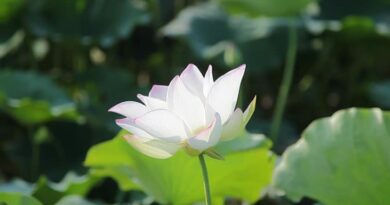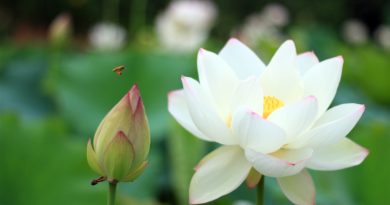THE JHĀNAS AND THE LAY DISCIPLE ACCORDING TO THE PĀLI SUTTAS – INTRODUCTION
THE JHĀNAS AND THE LAY DISCIPLE ACCORDING TO THE PĀLI SUTTAS – INTRODUCTION
The Pāli Nikāyas leave no doubt of the important role the jhānas play in the structure of the Buddhist path. In such texts as the Sāmaññaphala Sutta (DN No. 2), the Cūḷahatthipadopama Sutta (MN No. 27), and many others on the “gradual training” (anupubbasikkhā) of the Buddhist monk, the Buddha invariably introduces the jhānas to exemplify the training in concentration. When the bhikkhu has fulfilled the preliminary moral discipline, we read, he goes off into solitude and cleanses his mind of the “five hindrances.” When his mind has been so cleansed, he enters and dwells in the four jhānas, described by a stock formula repeated countless times in the Nikāyas:
Here, bhikkhus, secluded from sensual pleasures, secluded from unwholesome states, a bhikkhu enters and dwells in the first jhāna, which is accompanied by thought and examination, with rapture and happiness born of seclusion. With the subsiding of thought and examination, he enters and dwells in the second jhāna, which has internal confidence and unification of mind, is without thought and examination, and has rapture and happiness born of concentration. With the fading away as well of rapture, he dwells equanimous and, mindful and clearly comprehending, he experiences happiness with the body; he enters and dwells in the third jhāna of which the noble ones declare: “He is equanimous, mindful, one who dwells happily.” With the abandoning of pleasure and pain, and with the previous passing away of joy and displeasure, he enters and dwells in the fourth jhāna, which is neither painful nor pleasant and includes the purification of mindfulness by equanimity.[1]
In Theravada Buddhist circles during the past few decades a debate has repeatedly erupted over the question whether or not jhāna is necessary to attain the “paths and fruits,” that is, the four graded stages of enlightenment. The debate has been sparked off by the rise to prominence of the various systems of insight meditation that have become popular both in Asia and the West, especially among lay Buddhists. Those who advocate such systems of meditation contend that the paths and fruits can be attained by developing insight (vipassanā) without a foundation of jhāna. This method is called the vehicle of bare insight (suddha-vipassanā), and those who practise in this mode are known as “dry insighters” (sukkha-vipassaka) because their practice of insight has not been “moistened” by prior attainment of the jhānas. Apparently, this system finds support from the Visuddhimagga and the Pāli Commentaries, though it is not given a very prominent place in the commentarial treatment of the path, which usually follows the canonical model in placing the jhānas before the development of insight.[2]
To help answer the question whether the jhānas are necessary for the attainment of the stages of awakening, we might narrow the question down by asking whether they are needed to reach the first stage of awakening, known as stream-entry (sotāpatti). Since the Nikāyas order the process of awakening into four stages — stream-entry, once-returning, non-returning, and arahantship — it is possible that the jhānas come to assume an essential role at a later stage in the unfolding of the path, and not at the first stages. Thus it may be that the insight required for the earlier stages does not presuppose prior attainment of the jhānas, while the jhānas become indispensable in making the transition from one of the intermediate stages to a more advanced stage. I myself believe there is strong evidence in the Nikāyas that the jhānas become an essential factor for those intent on advancing from the stage of once-returning to that of non-returner. I will review the texts that corroborate this thesis later in this paper.
Recently, however, several articulate teachers of meditation have argued down the validity of the dry insight approach, insisting that the jhānas are necessary for the successful development of insight at every stage. Their arguments usually begin by making a distinction between the standpoints of the Pāli Canon and the Commentaries. On this basis, they maintain that from the perspective of the Canon jhāna is needed to attain even stream-entry. The Nikāyas themselves do not address this problem in clear and unambiguous terms, and it is difficult to derive from them any direct pronouncement on its resolution. In the suttas dealing with the gradual training, all the stages of awakening are telescoped into one series, and thus no differentiation is made between the preparatory attainments required for stream-entry, once-returning, non-returning, and arahantship. We simply see the monk go off into solitude, attain the four jhānas, and then proceed directly to arahantship, called “the knowledge of the destruction of the taints.” From such texts, there can be no denying the role of the jhānas in bringing the path to fulfilment, but here I shall be concerned principally with the question whether or not they are categorically necessary to win the first fruit of the path.
In pursuing this question I intend to pick up an important but generally neglected clue the suttas lay at our doorstep. This is the fact that many of the Buddha’s followers who attained the first three stages of awakening, from stream-entry through non-returning, were lay people. The only stage that the Canon depicts as the near-exclusive domain of monks and nuns is arahantship.[3] This clue is more important than might appear at first glance, for a close examination of texts describing the personal qualities and lifestyles of noble lay disciples might bring to light just the material we need to unravel the knots tied into this perplexing issue.
A study of the Nikāyas as a whole would show that they depict classes of disciples in terms of paradigms or archetypes. These paradigms are generally constructed with extreme rigor and consistency, indicating that they are evidently governed by a precisely determined scheme. Yet, somewhat strangely, it is rare for the outlines of this scheme to be spelled out in the abstract. This puts the burden on us to elicit from the relevant suttas the underlying principles that govern the portrayal of types. The texts with which we are concerned delineate disciples at different levels of development by way of clusters of specific qualities and practices. These texts function both descriptively and prescriptively. They show us what kinds of qualities we can normally expect of disciples at particular stages of progress, and thereby they imply (and sometimes state) what kinds of practices an aspirant at a lower stage should take up to advance further along the path.
To draw upon suttas dealing with lay disciples is to approach the question of the need for jhāna from an angle somewhat different from the one usually adopted. Most participants in this discussion have focused on texts dealing principally with monastic practice. The drawback to this approach, as indicated above, lies in the predilection of the Nikāyas to compress the successive levels of monastic attainment into a single comprehensive scheme without showing how the various levels of practice are to be correlated with the successive stages of attainment.[4] So instead of working with these monastic texts, I intend to turn my spotlight on the unordained segment of the Buddhist community and look at suttas that discuss the spiritual practices and qualities of the lay noble disciple. For if the jhānas are truly necessary to attain stream-entry, then they should be just as much integral to the practice of the lay follower as they are to the practice of the monk, and thus we should find texts that regularly ascribe jhānic practice and attainment to lay disciples just as we find them in the case of monks. If, on the other hand, the texts consistently describe the practices and qualities of certain types of noble lay disciples in ways that pass over or exclude the jhānas, then we have strong grounds for concluding that the jhānas are not prerequisites for attaining discipleship at these levels.
I will frame my study around three specific questions:
(1) Do the texts indicate that a worldling must attain jhāna before entering upon the “fixed course of rightness” (sammatta-niyāma), the irreversible path to stream-entry?
(2) Do the texts typically ascribe the jhānas to lay disciples who have attained stream-entry?
(3) If the texts do not normally attribute the jhānas to the stream-enterer, is there any stage in the maturation of the path where their attainment becomes essential?








